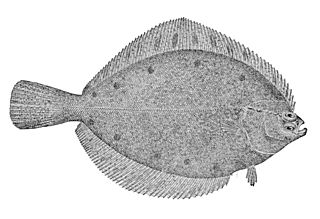 W
WAlaska plaice is a saltwater fish that live in the North Pacific Ocean. Alaska plaice are right-eye flounders which live on the sandy bottoms of the continental shelf, up to 600 metres deep. Their geographic range is from the Gulf of Alaska in the east, to the Chukchi Sea in the north, to the Sea of Japan in the west. Alaska plaice feed mostly on polychaetes, but also eat amphipods and echiurans.
 W
WThe Alaska pollock or walleye pollock is a marine fish species of the cod genus Gadus and family Gadidae. It is a semi-pelagic schooling fish widely distributed in the North Pacific, with largest concentrations found in the eastern Bering Sea.
 W
WAlburnus tarichi, known as the tarek, pearl mullet, Van fish or Van shah kuli, is a species of cyprinid fish, found only in Turkey, where it is the only fish known to inhabit Lake Van. It is endemic to the Lake Van basin. It is locally known in Turkish: İnci kefalı/balığı, Kurdish: darex darach, and Armenian: տառեխ taṙex.
 W
WThe belligerent sculpin is a species of sculpin native to the northern Pacific Ocean. This species grows to a length of 42 centimetres (17 in) TL )
 W
WThe Bering wolffish is a marine fish in the family Anarhichadidae, the "wolffish".
 W
WThe Black Sea salmon is a fairly small species of salmon, at about 20 inches (510 mm) long on average and rarely reaching over 30 in (760 mm). It inhabits the northern Black Sea coasts and inflowing rivers. There are anadromous, lacustrine and resident river populations. This fish is a close relative of the brown trout. While it is the only native species of Salmo present in the northern Black Sea basin, it may hybridize with (introduced) brown trout in the major rivers. Sea-run populations are currently at low numbers, but the resident river stocks are doing well.
 W
WThe blackhand sole is a fish species in the family Soleidae, common in the Mediterranean Sea, the Black Sea, and the Sea of Azov. It was considered a subspecies of the sand sole in past, as Pegusa lascaris nasuta. Therefore, it is sometimes mistakenly mentioned for the Black Sea fauna as Pegusa lascaris. Marine subtropical demersal fish, up to 17 cm long.
 W
WBlepsias cirrhosus, the silverspotted sculpin, is a scorpaeniform marine fish in the sea raven family Hemitripteridae, native to the northern Pacific Ocean from the Sea of Japan and Alaska to San Miguel Island off southern California. Its name originates from its elongated, sail-like first dorsal fin; the sailfin sculpin is also a popular subject in public aquariums. The fish exhibits a preying behavior of overrunning its prey, by rapidly accelerating just prior to capture, which it shares with other pelagic species such as Largemouth bass. This differs from other sculpin species that reside near the shore, such as the tidepool sculpin that instead decelerate during prey capture.
 W
WThe blueback herring or blueback shad is an anadromous species of herring from the east coast of North America, with a range from Nova Scotia to Florida. Blueback herring form schools and are believed to migrate offshore to overwinter near the bottom.
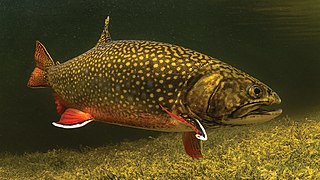 W
WThe brook trout is a species of freshwater fish in the char genus Salvelinus of the salmon family Salmonidae. It is native to Eastern North America in the United States and Canada, but has been introduced elsewhere in North America, as well as to Iceland, Europe, and Asia. In parts of its range, it is also known as the eastern brook trout, speckled trout, brook charr, squaretail, or mud trout, among others. A potamodromous population in Lake Superior, as well as an anadromous population in Maine, is known as coaster trout or, simply, as coasters. The brook trout is the state fish of nine U.S. states: Michigan, New Hampshire, New Jersey, New York, North Carolina, Pennsylvania, Vermont, Virginia, and West Virginia, and the Provincial Fish of Nova Scotia in Canada.
 W
WThe creek chubsucker is a freshwater fish of the sucker family (Catostomidae).
 W
WThe red-eye round herring is a species of fish belonging to the family Dussumieriidae, a family notable for their rounded bellies.
 W
WThe flat-faced seahorse, longnose seahorse, low-crowned seahorse or three-spot seahorse is a species of fish in the family Syngnathidae. It is found in Australia, Cocos (Keeling) Islands, French Polynesia, Hong Kong, India, Indonesia, Japan, the Philippines, Singapore, Taiwan, Thailand, and Vietnam. Its natural habitat is shallow seas. It is threatened by habitat loss.
 W
WThe flatsnout goby is a species of goby endemic to the Black Sea where it is mostly known from inshore waters amongst rocks and boulders. It is occasionally found offshore over areas with gravel substrates. This species can reach a length of 22.5 centimetres (8.9 in) TL.
 W
WThe giant goby is a species of goby native to coastal marine and brackish waters of the eastern Atlantic, the Mediterranean Sea and the Black Sea at depths of from 10 to 35 metres. This species is of minor importance to commercial fisheries and is also popular as a game fish.
 W
WThe golden shiner is a cyprinid fish native to eastern North America. It is the sole member of its genus. Much used as a bait fish, it is probably the most widely pond-cultured fish in the United States. It can be found in Quebec and its French name is "Mené jaune" or "Chatte de l'Est".
 W
WThe grass goby is a species of goby native to the Mediterranean Sea, the Sea of Azov and the Black Sea. It is currently the only known member of its genus.
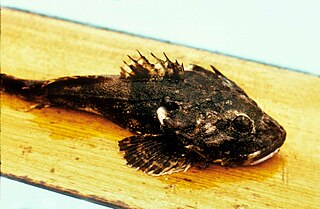 W
WThe great sculpin is a North Pacific species of sculpin in the family Cottidae. Its range encompasses the Bering Sea and the Aleutian Islands, and extends from Hokkaido and the Kamchatka Peninsula to the Puget Sound, Washington. It is the largest member of the genus Myoxocephalus and the second most common in the Bering Sea. It can grow to a size of 80 cm and 9 kg weight.
 W
WHemitripterus villosus, commonly known as the sea raven, is a species of fish belonging to the family Hemitripteridae. It is native to the northwestern Pacific Ocean off the coast of Russia and Japan.
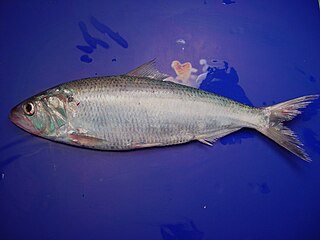 W
WThe hickory shad is a member of the herring family Clupeidae, ranging along the East Coast of the United States from Florida to the Gulf of Maine. It is an anadromous fish species, meaning that it spawns in freshwater portions of rivers, but spends most of its life at sea. It is subject to fishing, both historic and current, but it is often confused with or simply grouped together with catch statistics for American shad.
 W
WThe lake minnow or swamp minnow is a Eurasian species of small freshwater cyprinid fish. It has a wide but disjunct distribution including parts of Europe and Asia.
 W
WThe longhorn sculpin is a Northwest Atlantic species of sculpin in the fish family Cottidae. It is a predatory and scavenging fish that can feed on the remains of other organisms.
 W
WThe monkey goby is a species of goby native to the basins of the Black Sea and the Sea of Azov.
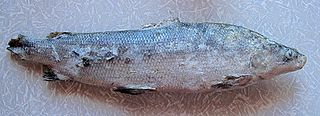 W
WThe muksun (Coregonus muksun) is a type of whitefish widespread in the Siberian Arctic waters. It is mostly found in the freshened areas of the Kara and Laptev Seas and up the major rivers, as well as in Lake Taymyr.
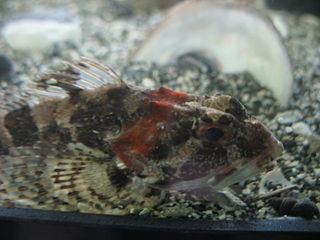 W
WMyoxocephalus aenaeus. commonly known as the grubby, or little sculpin, is a species of sculpin in the fish family Cottidae.
 W
WThe pond smelt is a freshwater species of smelt that inhabits the Arctic.
 W
WProterorhinus marmoratus is a species of gobiid fish, a tubenose goby native to the brackish water parts of the Black Sea and the Sea of Azov, near the coasts of Bulgaria, Georgia, Romania, Ukraine and Russia. Also it is found in the Marmora Sea (Turkey). It can reach a length of 11.5 centimetres (4.5 in) TL.
 W
WThe rainbow smelt is a North American species of fish of the family Osmeridae. It was introduced to the Great Lakes, and from there has made its way to various other places. Walleye, trout, and other larger fish prey on these smelt. The rainbow smelt prefer juvenile ciscoes, zooplankton such as calanoid copepods, and other small organisms, but are aggressive and will eat almost any fish they find. They are anadromous spring spawners and prefer clean streams with light flow and light siltation. The rainbow smelt face several barriers. They are weak swimmers and cannot overcome most fish ladders. This prevents them from making it past the dams to the headwater streams where they spawn. The rise in erosion and dams helped to decimate the smelt population in the 1980s. There are currently plans to try to reduce damming and to help control erosion. With current efforts to reduce the human impact on this and many other affected species the population is back on the rise.
 W
WCallionymus risso, Risso's dragonet, is a species of dragonet native to the Mediterranean Sea as well as the Black Sea and rarely found off of Portugal in the Atlantic Ocean. This species can be found at depths of from 15 to 150 metres. Males of this species grows to a length of 11 centimetres (4.3 in) TL while females reach a length of 6.5 centimetres (2.6 in).
 W
WThe round goby is a euryhaline bottom-dwelling goby of the family Gobiidae, native to central Eurasia including the Black Sea and the Caspian Sea. Round gobies have established large non-native populations in the Baltic Sea, several major Eurasian rivers, and the North American Great Lakes.
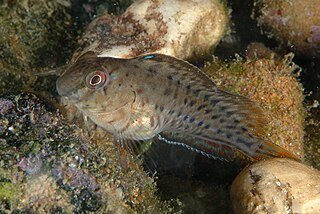 W
WThe rusty blenny or Black Sea blenny is a species of combtooth blenny found in the eastern Atlantic: Loire mouth, France to Morocco including the Mediterranean and Black Sea. This species reaches a length of 20 centimetres (7.9 in) TL.
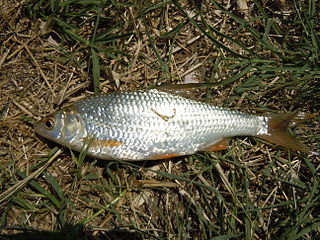 W
WRutilus heckelii is a species of roach, a genus in the family Cyprinidae. This species occurs in the Black Sea and Caspian Sea basins, the Azov Sea itself, and even in drainage areas of the White Sea.
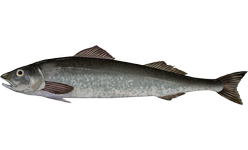 W
WThe sablefish is one of two members of the fish family Anoplopomatidae and the only species in the genus Anoplopoma. In English, common names for it include sable (US), butterfish (US), black cod, blue cod (UK), bluefish (UK), candlefish (UK), coal cod (UK), snowfish (ปลาหิมะ) (Thailand), coalfish (Canada), beshow, and skil (Canada), although many of these names also refer to other, unrelated, species. The US Food and Drug Administration accepts only "sablefish" as the Acceptable Market Name in the United States; "black cod" is considered a vernacular (regional) name and should not be used as a Statement of Identity for this species. The sablefish is found in muddy sea beds in the North Pacific Ocean at depths of 300 to 2,700 m and is commercially important to Japan.
 W
WSalvelinus leucomaenis, the whitespotted char, is an East Asian trout in the genus Salvelinus, called iwana in Japanese. Both landlocked and ocean-run forms occur. The landlocked form typically grows up to 35 cm, and prefers low-temperature streams. The seagoing fish typically grows to 70 cm (28 in) long. The largest reported specimen was 120 cm long and the oldest was nine years old.
 W
WScophthalmus maeoticus is a fish species in the family Scophthalmidae. It is widespread in the Black Sea. It is sometimes treated as a subspecies of the turbot, Scophthalmus maximus, which is common in the Mediterranean Sea. The taxonomic status of this species is under discussion. It is an important commercial species.
 W
WThe silver hake, Atlantic hake, or New England hake is a merluccid hake of the genus Merluccius, found in the northwest Atlantic Ocean. It is highly predatory and typically feeds on fish and crustaceans.
 W
WLiparis callyodon, or the spotted snailfish and by one source the beautiful tooth seasnail, is a fish from the genus Liparis. It lives in marine and demersal environments at a depth range from zero to twenty meters. It can be found at temperate climate zones, such as the eastern Pacific Ocean from Alaska, USA to Oregon, USA, in intertidal zones. The name callyodon comes from the Greek word meaning "beautiful tooth". Pallas chose this name after the species' tricuspid teeth.
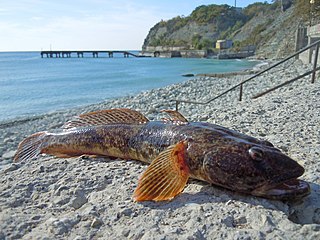 W
WMesogobius batrachocephalus, the knout goby or toad goby, is one of the species of gobiid fish native to the Black Sea and the Sea of Azov basins. It lives in estuaries and brackish water lagoons, occasionally in fresh waters, such as the coastal Lake Siutghiol in Romania. It prefers areas near cliffs with sandy, shelly or rocky substrates at depths of from 20 to 60 metres, sometimes down to 100 metres (330 ft). The knout goby is a piscivore. It can reach a length of 34.5 centimetres (13.6 in) SL and weight of 600 grams (1.3 lb). Maximum known age is eight years.
 W
WWhite-eye bream is a fish species of the family Cyprinidae. It is widespread in many large rivers in Europe and Asia in drainages of the Black Sea, Caspian Sea, and Aral Sea. It was introduced to several rivers in northern Russia, the Rhine, and the Vistula drainage system where it is invasive, coming from the Black Sea basin through the Dnieper–Bug Canal. Freshwater fish are up to 35 cm long.
 W
WThe yellow perch, commonly referred to as perch, striped perch, American perch, American river perch or preacher is a freshwater perciform fish native to much of North America. The yellow perch was described in 1814 by Samuel Latham Mitchill from New York. It is closely related, and morphologically similar to the European perch ; and is sometimes considered a subspecies of its European counterpart. Other common names for yellow perch include American perch, coontail, lake perch, raccoon perch, ring-tail perch, ringed perch, and striped perch. Another nickname for the perch is the Dodd fish.
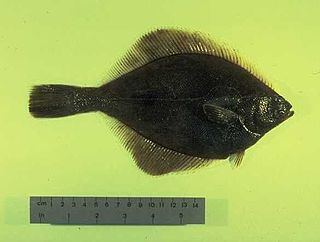 W
WThe yellowfin sole is a flatfish of the family Pleuronectidae. It is a demersal fish that lives on soft, sandy bottoms at depths of up to 700 metres (2,300 ft), though it is most commonly found at depths of around 91 metres (299 ft). Its native habitat is the temperate waters of the northern Pacific, from Korea and the Sea of Japan to the Sea of Okhotsk, the Bering Sea and Barkley Sound on the west coast of Canada. Males grow up to 49 cm (19 in) in length, though the common length is around 33.5 cm (13.2 in). The maximum recorded weight is 1.7 kg (3.7 lb), and the maximum recorded lifespan is 26 years.